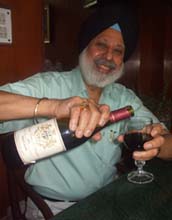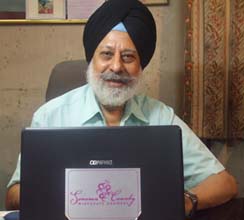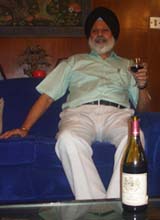‘Go West, young man’ may be the motto being followed by most wine producers looking for the pot of gold and rushing to ‘Nashik’, their Napa in California, but 'Think North’ is the advisory from Avtar Singh Sandhu, the owner of Mushal Winery in Dry Creek Valley in Sonoma County, with whom Subhash Arora touched base recently at his Delhi residence.
 What do Rajeev Samant and Avtar Singh Sandhu have in common, - besides being Indians and producing wine? What do Rajeev Samant and Avtar Singh Sandhu have in common, - besides being Indians and producing wine?
The wine consultant Kerry Damskey of Sonoma!
While Kerry has been a wine consultant for Sula since its conception in 1999-2000, he was engaged by Avtar Singh Sandhu living in the same area to help him grow Sauvignon Blanc in 1983 and ‘is still our consultant,’ says Sandhu, whom I met over a cup of tea during his annual long-stay in his Lutyens Delhi Bungalow.
Originally a resident of Delhi, with an engineering education and work experience in Delhi and California, he moved to San Francisco in the seventies and then to Sonoma County, less than an hour's drive away.
‘What made you buy vineyard land in Sonoma when you had such a wonderful job with Bechtel, I ask?’ He says smilingly, ‘you know I am a jaat from Punjab. We have a problem-unless we dirty our hands in the soil, on our own land, we cannot rest. Since we had shifted to California, I wanted to buy some nearby land for farming. The big farmers have huge chunks of land and grow rice, wheat, cotton etc. The quality farming was in grapes. So I scouted around and landed up in Geyserville where I bought 56 acres of vineyard land in the Dry Creek Valley in 1978,’ he says.
In his pursuit for excellence in grape growing he was advised by the late Dr Maynard Amerine, Professor Emeritus of Enology in UC Davies, who was very fond of India and focused on how to determine whether an area was good for grape cultivation and came up with the concept of ‘degree days.’
The first crop was taken in 1982 and in 1983 he hired the services of Kerry Damskey. ‘Initially we grew Sauvignon Blanc. Then in 1990, the 60-minute programme was broadcast on NBC (The French Paradox about which many articles have been written in delWine), singing songs about red wine and its benefit for the heart and the sale of white wine dried up overnight. People shifted to red wine and we were left with no option but to switch to the red- and we planted Merlot by grafting on top of the Sauvignon Blanc rootstock.
Sideways shift post -Sideways
Like the proverbial Stock Market Crash, Sandhu suffered yet another crash with the movie ‘Sideways’ coming like a Tsunami in 2004. This pushed the Merlot grape sideways, bringing Pinot Noir to the central stage. ‘We also grow Cabernet Sauvignon but merlot grows very well on our soil. So we don’t want to change to another varietal.’
What has been the negative impact of the movie? ‘Well, the fruit used to sell at US $2200/ton (US ton is slightly lesser than metric tonne) but with the effect of the movie and the recent recession, the price has come down to US $1200/ton-which works out to around $1300/tonne.’ To put things in proper perspective, the Sauvignon Blanc sells higher at $1700/ ton now.
Grower not the Vintner
 Sandhu likes to be known more as a grower than a wine producer. Though he has the capacity to produce 8000 cases of wine, he makes wine only out of the unsold grapes-and at times he lets a part of them drop too. ‘I like to sell grapes as such and not as wines, if I have an option. One has to block the inventory for 2-3 years. The maximum quantity we end up doing is about 4000 cases’, he says. The 2006 that has won the medal was from a harvest that yielded good quality and quantity of fruit. Sandhu likes to be known more as a grower than a wine producer. Though he has the capacity to produce 8000 cases of wine, he makes wine only out of the unsold grapes-and at times he lets a part of them drop too. ‘I like to sell grapes as such and not as wines, if I have an option. One has to block the inventory for 2-3 years. The maximum quantity we end up doing is about 4000 cases’, he says. The 2006 that has won the medal was from a harvest that yielded good quality and quantity of fruit.
Medals Galore- Man of Bronze
DelWine keeps on getting news about Avtar winning medals for one or the other of his wines at various competitions, especially the Merlot. Unlike our ace runner Milkha Singh who missed the solitary potential Bronze in the Rome Olympics, this burly jaat Sikh engineer from the village of Mushal on which his winery is named, and who I had first met 36 years ago, both of us working in Delhi for Engineers India Ltd., has had a successful run with several Bronzes. In fact, he had just received a message from his winery when I met him telling him that his Merlot 2006 had won a Bronze at the County2010 NextGen Millennial Wine Competition in the US.
While it might be a reason for him and us to rejoice about a fellow Indian (even though he has shifted base to California) getting many winemaking awards, but when would he get a Gold Medal, I ask him. He laughs and says, ‘that’s the same question I keep asking my winemakers and whosoever is qualified to answer-we keep on getting Bronzes and an occasional Silver but why not Gold.’
Sample Selection Crucial
Sandhu seems to have discovered the key to get the Gold. ‘Most producers who get a Gold are focusing on a very small parcel of land and they look after the grape and wine production very keenly, producing a very small quantity, whereas I pick out any bottle from my regular production. For instance, the Merlot which has been now awarded was picked up by us at random from my warehouse whereas these producers handcraft a very small quantity which may or may not have any relationship with the wine produced at large. In fact, recently, a Merlot winning a Gold had to return the medal since they could not produce 75 cases, the minimum number they were supposed to have had, based on the rules of the competition.
Sandhu has a word of advice for anyone willing to take it- the wineries should not send the samples. They must be asked to designate 2 or 3 retailers from where the organisers could choose wines at random.
Words of wisdom that can be very useful even in India where many participants insinuate that the samples sent are made especially for the competition. Sandhu is also critical of very small number of cases as the threshold limit. I give my Merlot from a total production of 55 tons of grapes. It is not fair to compare my Merlot with a specially handcrafted wine selling at 3-5 times my price,’ he asserts
Go North, Mr. Producer
‘Many people ask me why no one is thinking of planting wine grapes in the North of Delhi?’ My answer is simple and definite, ‘I have done a lot of research and studied the whole belt of Punjab from Anandpur Sahib to Yamunanager, at the foothills of Shivalik hills. The temperature is cooler, the day-night temperature difference is sufficiently large, the land is barren and great for wine and olive trees- and the big bonus is that the monsoons come 3 weeks later, making it an area where the ripening can be complete.’
 Why are the farmers not going to that area, then? ‘Frankly, it requires a political will and some hungry industrialist who is a pioneer for that region. The land is cheap. With drip irrigation, the water requirements can be minimal. But the farmer wants to know if he would be able to sell the grapes when he harvests. So you need wineries to pick up the grapes. Punjab needs to come out with a Maharashtra type of policy. Since I don’t live here, I don’t have any political contacts.’ Decrying the efforts of the government in setting up the Bhatinda winery, he says, ‘not only is the summer temperature too high, the land is prohibitive. I don’t think with the land prices being as high as they are, one can ever be competitive in the international markets.’ Why are the farmers not going to that area, then? ‘Frankly, it requires a political will and some hungry industrialist who is a pioneer for that region. The land is cheap. With drip irrigation, the water requirements can be minimal. But the farmer wants to know if he would be able to sell the grapes when he harvests. So you need wineries to pick up the grapes. Punjab needs to come out with a Maharashtra type of policy. Since I don’t live here, I don’t have any political contacts.’ Decrying the efforts of the government in setting up the Bhatinda winery, he says, ‘not only is the summer temperature too high, the land is prohibitive. I don’t think with the land prices being as high as they are, one can ever be competitive in the international markets.’
‘Why can’t someone like Sula take up the issue?’ he wonders. With a planned sales growth of 100,000 cases this year and an accelerating growth, it is highly unlikely that Sula has time for new frontiers, I tell him. Sooner or later, some industrialist with a passion for wines will wake up to the fact that the best Indian wines will perhaps come from areas other than Maharashtra. Punjab, Uttaranchal Pradesh and Himachal Pradesh in the North would be a good bet. One cannot rule out Kashmir though at present the possibility is very remote. Areas of Karnataka and Andhra Pradesh also offer further scope of discovery.
That should make Avtar Singh Sandhu of Geyserville, Dry Creek Valley in California’s Sonoma Valley very happy and proud of his heritage.
An earlier interview with Sandhu, visit http://www.indianwineacademy.com/item_3_276.aspx
Subhash Arora
|